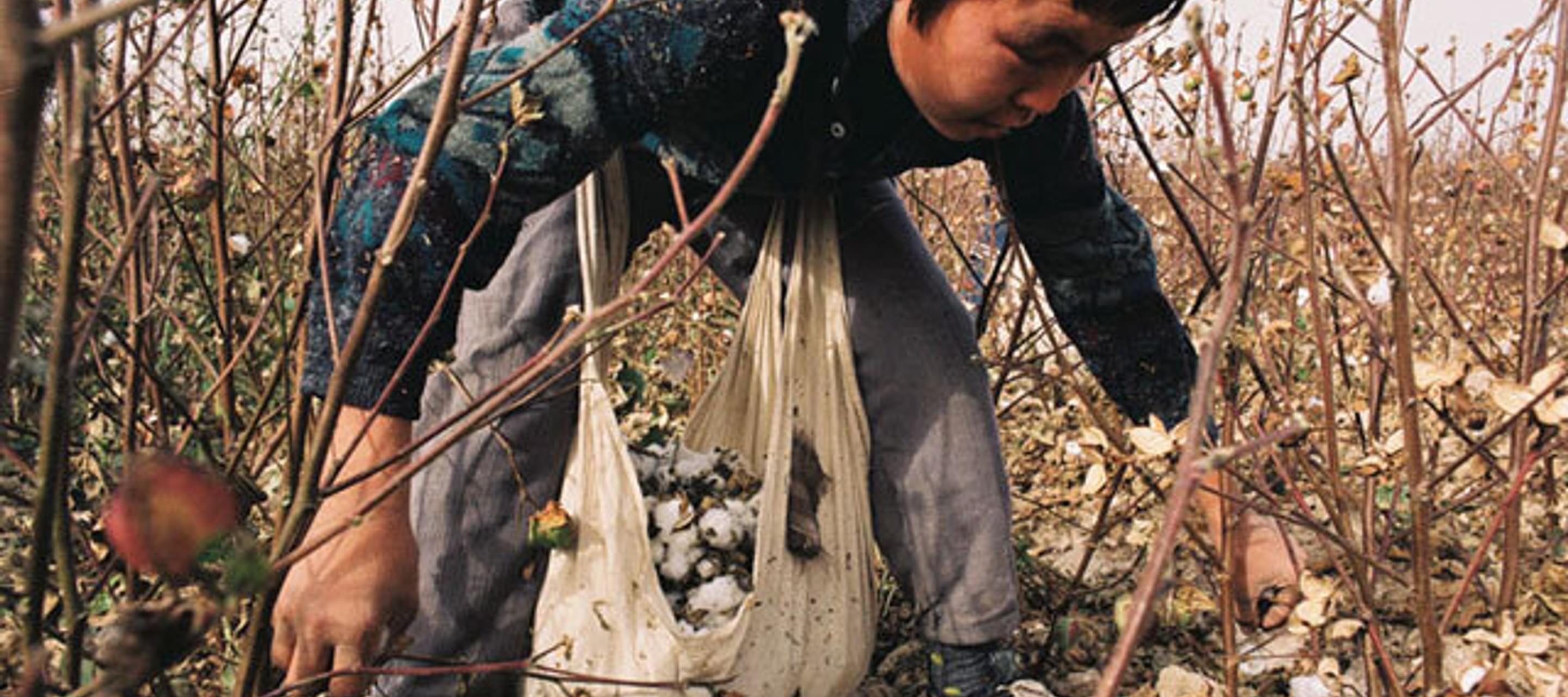The Bitter Harvest of Uzbek Cotton
24 November 2009

Once again in Uzbekistan this autumn, another bitter harvest is ending. Observers from different regions around the country are reporting that between 1.5 and 2 million teenagers, as well as children as young as nine years old, are missing school and instead picking cotton.
Uzbekistan's cotton fields make it the third largest exporter of raw cotton in the world and generate approximately $1 billion a year in export earnings for its repressive government, which not only requisitions all revenue from cotton but also directly mobilizes child labour to harvest it.
Child labour remains pervasive in the 21st century world, with stubborn economic and social roots in dozens of countries even as progress has been made under the auspices of the International Labour Organization (ILO) and on the part of many nations to eliminate at least its “worst forms.” Yet it is the degree of forced child labour directly mobilized by different levels of the Uzbek Government and coordinated in Tashkent that makes the situation unusual if not unique—at least in the global cotton sector. And the issue has put the Uzbek Government in the international spotlight on forced labour as no other government has been to the same degree since Burma a decade ago.
That spotlight has been trained not only by the international media but also increasingly by a coalition of major apparel brands, investors, human and labour rights organizations and trade unions that has taken shape to directly address the issue of forced child labour in Uzbekistan.
Beginning in the UK and elsewhere in Europe with major brands such as Tesco and Marks & Spencer and NGOs such as the Open Society Institute and the Environmental Justice Foundation, the coalition extended across the Atlantic to the U.S. beginning in late 2007 with the International Labour Rights Forum and the shareholder advocate As You Sow bringing together SRIs, faith-based investors, unions and a number of major American brands.
Since then, a well-coordinated campaign has emerged that demonstrates some of the progress that can be made but also dilemmas that must be faced at a time when business is testing new roles with respect to human rights.
That progress came with remarkable speed. By spring 2008 the coalition had quickly developed and agreed on a common strategy comprised of two key elements of pressure and engagement: first, to build pressure on the Uzbek Government by gaining commitments of apparel brands to ban sourcing their cotton until the Uzbek Government publicly acknowledges the problem and commits credibly to address it; second to engage the Uzbek Government to acknowledge and address the problem most fundamentally on its own but also in coordination with the ILO and other sources of technical assistance. Such assistance should begin with an assessment mission to lay the basis for a multi-year engagement with the explicit mission of eliminating the use of child labour to harvest the country's cotton crop (whether through all adult workers and/or mechanization).
Beyond the clarity of the coalition's fundamental objective, three additional qualities have made this coalition particularly distinctive as a paradigm for the distance that business support for human rights—at least in this sector—has travelled.
First, the coalition includes not only companies that have long been committed to addressing labour and human rights issues such as Levi’s and Gap, but also Wal-Mart [1]. Until recently Wal-Mart has been a laggard in this regard but nonetheless has emerged as a leader among the companies in the Uzbek cotton coalition at the same time that it is beginning to extend its labour and human rights commitments across its massive global supply chain.
Second, the degree of coordination and strategic cohesion among the companies (and their trade associations), investors, NGOs and unions is unusual. While the different elements of the coalition bring distinct interests and perspectives to its deliberations, a common approach has been maintained with relative ease and the common messages have been delivered in every external meeting—whether with the ILO, the International Cotton Advisory Council, the U.S. Government and, most important, the Government of Uzbekistan (with which there have been two high-level meetings over the last year).
Third, the willingness of the brands to meet directly with the Uzbek Government and to lodge a complaint through the employers group of the ILO demonstrates that in this context they define their corporate responsibility as not only making a business decision but also taking a policy position in the broader interest of the industry. While urging the Uzbek Government to eliminate forced child labour from the cotton sector in conjunction with the ILO and others, the brands are at the same time pointing to a pathway through which they may restore their sourcing if there are concrete, credible commitments, progress towards this clear objective, and independent verification of the results. This advocacy is given greater credibility by the concurrent steps the brands are taking to develop tracing mechanisms to ensure that their commitments to curtail sourcing of Uzbek cotton can be tracked and driven through their global supply chains. The brands’ activism reflects the responsibility that they believe they share in diminishing child labour and diminishing the chances that “child cotton” may join “conflict diamonds” in the lexicon.
Yet for all of these positive qualities that have characterized the coalition thus far and made it a model for others to come, it has nonetheless run up against some hard realities that demonstrate the difficulty of achieving its objective.
The fact is that even with the growing move to curtail sourcing of Uzbek cotton and the increasingly harsh spotlight being brought to bear, the Uzbek Government once again mobilized hundreds of thousands of children in the fields this autumn.
Moreover, the government was able to sell the full crop to buyers from around the world at the International Uzbek Cotton Fair in October—thus reinforcing its apparent confidence that it can deflect the growing pressure and still reap its harvest and profits alike.
What, then, makes the Uzbek Government so resistant to pressure thus far? First and foremost is its determination to retain control of the entire cotton crop—from harvest to sale—to ensure that it continues to control this major source of export revenue and foreign exchange earnings. Second is its apparent disinclination to work with the ILO on child labour (or other issues) as dozens of other countries have in recent years and its decision instead to move ahead with its own National Action Plan to implement the ILO child labour conventions it recently ratified without international assistance—while at the same time continuing to mobilize forced child labour on a massive scale. Finally, there is the nature of the regime itself and its ability to withstand international pressure on human rights issues, especially in the wake of the killing of hundreds of unarmed protestors in Andijan in May 2005.
The coalition's diplomatic engagement with the Uzbek Government may have run its course, even as efforts are being made to renew contact. The pressure must build even as channels of engagement are maintained.
It is time to widen the circle of companies and investors as well as NGOs and trade unions, on both sides of the Atlantic and around the world, prepared to join forces on the issue. Now is the time to extend and tighten tracing procedures being developed and applied to make sure that company supply chains are free of Uzbek cotton. The purchasers in this year’s cotton harvest in Uzbekistan need to be first privately approached and later, if necessary, publicly identified if they are unwilling to curtail their willingness to buy Uzbek cotton. Plus, as engagement with Tashkent continues, the ILO should remain ready to accept an invitation from the Uzbek government that may yet materialize to deploy the kind of technical assistance mission that over several years could indeed help solve the problem.
It is too early to tell whether this effort will ultimately succeed in its objectives—and whether this or the next generation of Uzbek children will benefit. But the business and human rights community will watch with great interest as the possibilities and limits alike are tested by such a diverse coalition on such a compelling issue.
[1] As of 10/31/09, securities issued by Gap Inc. represented 0.30% of the net assets of CSIF Enhanced Equity and 0.17% of Calvert Social Index Fund. Securities issued by Wal-Mart Stores Inc. represented 1.86% net assets of Calvert Large Cap Value Fund.




